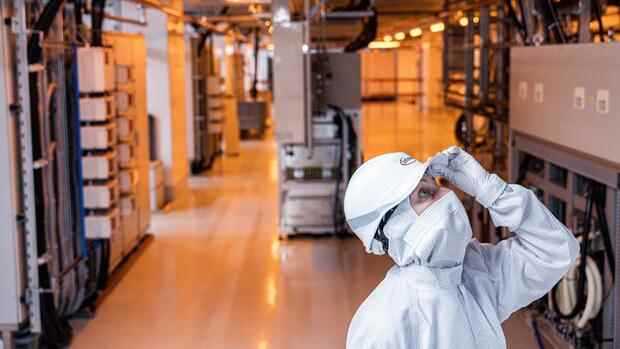The group presented its quarterly figures on Thursday.
(Photo: Bloomberg)
Munich Sold out: Infineon has orders worth more than 31 billion euros on its books. This means that the Munich chip manufacturer’s plants are working at full capacity for the next two years. “Our outlook is determined by the available capacities – our own and those of the contract manufacturer,” said CEO Reinhard Ploss this Thursday.
Infineon could sell many times that if the Dax group only had the necessary machines and staff. Even so, business is going brilliantly: The Dax group announced that sales in the past quarter had increased by 20 percent to around 3.2 billion euros. The bottom line was a profit of 457 million euros, 79 percent more than in the same period last year. The operating margin was 22.7 percent. Infineon has not been this profitable for a long time.
As with Germany’s largest chip group, almost all major semiconductor manufacturers worldwide are booming. Qualcomm boss Cristiano Amon: “We still have more demand than supply,” said the CEO of the world’s largest cell phone chip provider on Wednesday evening. “I wish we had more supplies.” With his forecast for the current quarter, the manager was almost a billion dollars above analysts’ expectations, and profits will also increase more than the bankers calculated.
>>Read here: How the EU wants to bring modern semiconductor factories to Europe
Top jobs of the day
Find the best jobs now and
be notified by email.
Take AMD as an example: At an analyst conference in midweek, CEO Lisa Su promised first-quarter sales of $5 billion, $700 million more than bankers had expected. For the whole year, the proceeds of the American processor specialist are expected to increase by almost a third. Processors are the brains of every computer.
Su assumes that the upswing will last: “We expect long-term growth over the next five years because people need more computer power.”
Chip industry expects permanent upswing
Kurt Sievers, head of Infineon’s rival NXP, is also optimistic: “We continue to see growing customer demand that exceeds supply, as inventories in all end markets are still very meager.” year 2022″.
After the record year 2021, the industry is heading for the next peak – and probably for several good years. But investors are cautious. This week, the prices of chip shares worldwide have risen in the meantime. Already on Thursday things went downhill again. Despite the brilliant numbers, Infineon was the biggest loser in the Dax with a drop of a good four percent.
The share prices of most major chip companies have been under pressure since the fall. Investors are nervous, fearing a flight from tech stocks.
CEO Reinhard Ploss has orders for the next two years on the books.
(Photo: ddp/Sven Simon)
Because many semiconductor stocks are comparatively expensive. The world’s most valuable chip company, Nvidia, is currently valued at 75 times expected annual earnings. Infineon has a price-to-earnings (P/E) ratio of around 40 and NXP 37. For comparison: Apple’s P/E is only 29.
Infineon shares are a fifth below their high
The Infineon shares were listed on Thursday at 35 euros and thus around a fifth below the high of mid-November. The analysts are in a very positive mood. The key figures and the outlook for the semiconductor group for 2022 had exceeded expectations, judged JPMorgan analyst Sandeep Deshpande on Thursday. The banker sees the price rising to 47 euros, which corresponds to an increase of around a third compared to the current price.
Goldman Sachs even assumes an increase of around half. According to analyst Alexander Duval, sales and operating results were better than the market had expected. Credit Suisse analysts write that the upgraded outlook could even turn out to be conservative.
In fact, a sudden downturn in the industry seems all but impossible. “The incoming orders are significantly larger than the cancellations,” explained Infineon CEO Ploss. In the most recent quarter, the order backlog had even climbed by two billion euros.
The head of the group increased the forecast for the current financial year, which ends on September 30th. The manager now expects sales of 13 billion euros, which is 300 million more than previously expected. The operating margin is expected to rise to 22 percent, one percentage point more than previously planned.
More: Takeover thriller about Siltronic: Habeck’s Ministry of Economics lets the deal burst


